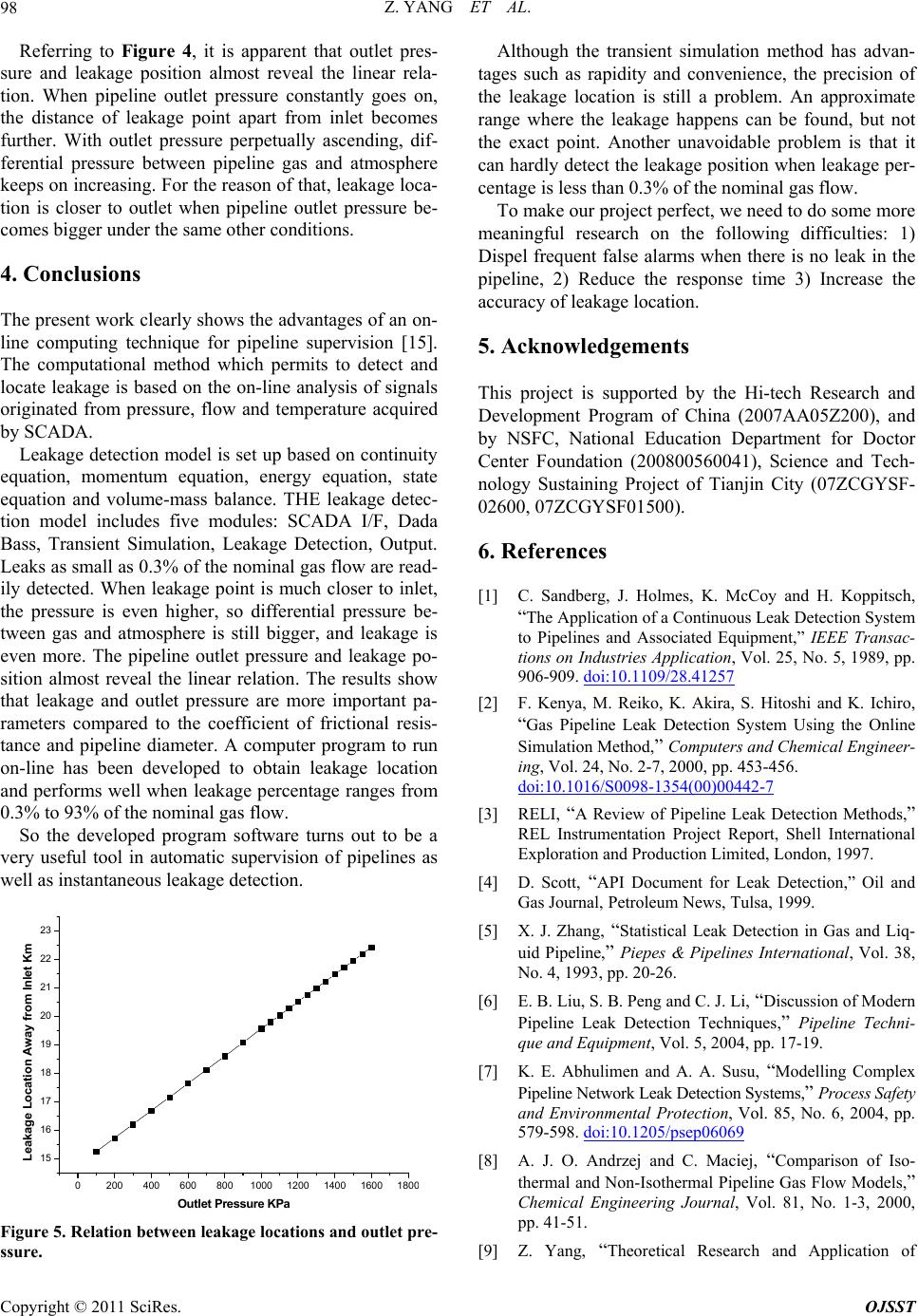
Z. YANG ET AL.
98
Referring to Figure 4, it is apparent that outlet pres-
sure and leakage position almost reveal the linear rela-
tion. When pipeline outlet pressure constantly goes on,
the distance of leakage point apart from inlet becomes
further. With outlet pressure perpetually ascending, dif-
ferential pressure between pipeline gas and atmosphere
keeps on increasing. For the reason of that, leakage loca-
tion is closer to outlet when pipeline outlet pressure be-
comes bigger under the same other conditions.
4. Conclusions
The present work clearly shows the advantages of an on-
line computing technique for pipeline supervision [15].
The computational method which permits to detect and
locate leakage is based on the on-line analysis of signals
originated from pressure, flow and temperature acquired
by SCADA.
Leakage detection model is set up based on continuity
equation, momentum equation, energy equation, state
equation and volume-mass balance. THE leakage detec-
tion model includes five modules: SCADA I/F, Dada
Bass, Transient Simulation, Leakage Detection, Output.
Leaks as small as 0.3% of the nominal gas flow are read-
ily detected. When leakage point is much closer to inlet,
the pressure is even higher, so differential pressure be-
tween gas and atmosphere is still bigger, and leakage is
even more. The pipeline outlet pressure and leakage po-
sition almost reveal the linear relation. The results show
that leakage and outlet pressure are more important pa-
rameters compared to the coefficient of frictional resis-
tance and pipeline diameter. A computer program to run
on-line has been developed to obtain leakage location
and performs well when leakage percentage ranges from
0.3% to 93% of the nominal gas flow.
So the developed program software turns out to be a
very useful tool in automatic supervision of pipelines as
well as instantaneous leakage detection.
02004006008001000 1200 1400 1600 180
15
16
17
18
19
20
21
22
23
Leakage Location Away from Inlet Km
Outlet Pressure KPa
Figure 5. Relation between leakage locations and outlet pre-
ssure.
Although the transient simulation method has advan-
tages such as rapidity and convenience, the precision of
the leakage location is still a problem. An approximate
range where the leakage happens can be found, but not
the exact point. Another unavoidable problem is that it
can hardly detect the leakage position when leakage per-
centage is less than 0.3% of the nominal gas flow.
To make our project perfect, we need to do some more
meaningful research on the following difficulties: 1)
Dispel frequent false alarms when there is no leak in the
pipeline, 2) Reduce the response time 3) Increase the
accuracy of leakage location.
5. Acknowledgements
This project is supported by the Hi-tech Research and
Development Program of China (2007AA05Z200), and
by NSFC, National Education Department for Doctor
Center Foundation (200800560041), Science and Tech-
nology Sustaining Project of Tianjin City (07ZCGYSF-
02600, 07ZCGYSF01500).
6. References
[1] C. Sandberg, J. Holmes, K. McCoy and H. Koppitsch,
“The Application of a Continuous Leak Detection System
to Pipelines and Associated Equipment,” IEEE Transac-
tions on Industries Application, Vol. 25, No. 5, 1989, pp.
906-909. doi:10.1109/28.41257
[2] F. Kenya, M. Reiko, K. Akira, S. Hitoshi and K. Ichiro,
“Gas Pipeline Leak Detection System Using the Online
Simulation Method,” Computers and Chemical Engineer-
ing, Vol. 24, No. 2-7, 2000, pp. 453-456.
doi:10.1016/S0098-1354(00)00442-7
[3] RELI, “A Review of Pipeline Leak Detection Methods,”
REL Instrumentation Project Report, Shell International
Exploration and Production Limited, London, 1997.
[4] D. Scott, “API Document for Leak Detection,” Oil and
Gas Journal, Petroleum News, Tulsa, 1999.
[5] X. J. Zhang, “Statistical Leak Detection in Gas and Liq-
uid Pipeline,” Piepes & Pipelines International, Vol. 38,
No. 4, 1993, pp. 20-26.
[6] E. B. Liu, S. B. Peng and C. J. Li, “Discussion of Modern
Pipeline Leak Detection Techniques,” Pipeline Techni-
que and Equipment, Vol. 5, 2004, pp. 17-19.
[7] K. E. Abhulimen and A. A. Susu, “Modelling Complex
Pipeline Network Leak Detection Systems,” Process Safety
and Environmental Protection, Vol. 85, No. 6, 2004, pp.
579-598. doi:10.1205/psep06069
[8] A. J. O. Andrzej and C. Maciej, “Comparison of Iso-
thermal and Non-Isothermal Pipeline Gas Flow Models,”
Chemical Engineering Journal, Vol. 81, No. 1-3, 2000,
pp. 41-51.
[9] Z. Yang, “Theoretical Research and Application of
Copyright © 2011 SciRes. OJSST